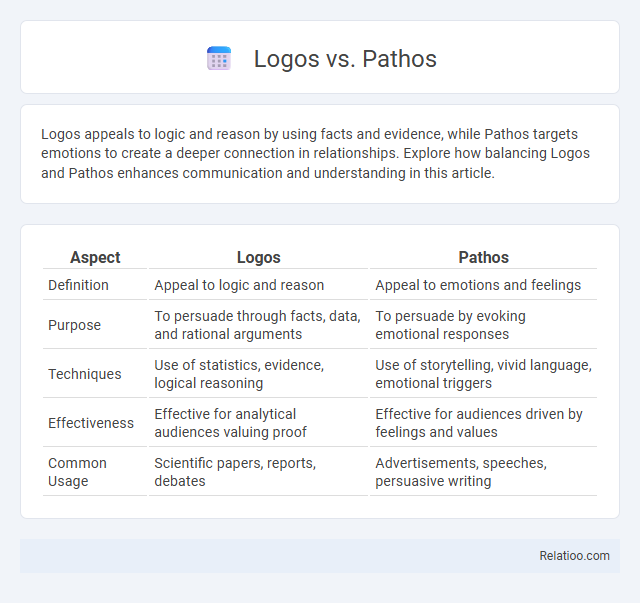Logos appeals to logic and reason by using facts and evidence, while Pathos targets emotions to create a deeper connection in relationships. Explore how balancing Logos and Pathos enhances communication and understanding in this article.
Table of Comparison
| Aspect | Logos | Pathos |
|---|---|---|
| Definition | Appeal to logic and reason | Appeal to emotions and feelings |
| Purpose | To persuade through facts, data, and rational arguments | To persuade by evoking emotional responses |
| Techniques | Use of statistics, evidence, logical reasoning | Use of storytelling, vivid language, emotional triggers |
| Effectiveness | Effective for analytical audiences valuing proof | Effective for audiences driven by feelings and values |
| Common Usage | Scientific papers, reports, debates | Advertisements, speeches, persuasive writing |
Understanding Logos and Pathos
Logos and pathos are fundamental modes of persuasion that appeal to logic and emotions, respectively. Logos uses facts, statistics, and rational arguments to establish credibility and convince the audience through clear evidence and reasoning. Pathos taps into the audience's feelings, values, and beliefs to evoke emotional responses that motivate action or agreement.
The Core Principles of Logos
Logos centers on logical reasoning, using facts, statistics, and clear evidence to support arguments effectively. Your ability to present coherent data and structured reasoning strengthens persuasion by appealing to the audience's rationality. Mastering logos involves crafting arguments with clarity, consistency, and verifiable proof to enhance credibility and influence decisions.
The Emotional Power of Pathos
Pathos leverages emotional appeal to influence audiences by evoking feelings such as empathy, anger, or joy, making arguments more relatable and compelling. This emotional connection enhances persuasion by engaging the audience's values and beliefs, often motivating action more effectively than logical reasoning alone. Effective use of pathos complements logos and ethos, creating a balanced rhetorical strategy that deeply resonates with listeners.
Comparing Logical and Emotional Appeals
Logical appeals, or logos, rely on facts, statistics, and rational arguments to persuade your audience through clear reasoning and evidence-based conclusions. Emotional appeals, or pathos, influence your audience by evoking feelings such as fear, happiness, or sadness, creating a strong emotional connection that motivates action. Understanding when to use logos versus pathos enhances your ability to craft compelling messages that effectively persuade diverse audiences.
When to Use Logos in Persuasion
Use logos in persuasion when addressing logical thinkers who value evidence-based arguments, such as in academic, scientific, or technical discussions. Emphasize statistics, facts, and clear reasoning to build credibility and support your claims effectively. This approach strengthens persuasive impact by appealing to rationality and minimizing emotional bias.
Harnessing Pathos for Impact
Harnessing pathos enhances your persuasive communication by evoking emotions to connect deeply with your audience, making your message more memorable and compelling. Unlike logos, which appeals to logic, pathos taps into feelings such as empathy, passion, or urgency to motivate action effectively. Your ability to balance emotional appeal with factual evidence maximizes persuasion in speeches, marketing, and storytelling.
Common Pitfalls of Relying on Logos
Relying heavily on logos in persuasion often leads to overlooking emotional resonance, causing messages to appear cold or unrelatable, which can diminish audience engagement. Overemphasizing logical arguments may neglect the importance of pathos, resulting in failure to motivate or inspire action despite sound reasoning. Effective persuasion requires balancing logos with emotional appeal and credibility to connect fully with diverse audiences.
Risks of Overusing Pathos
Overusing pathos in persuasion can lead to emotional manipulation, causing your audience to distrust your message or perceive it as insincere. Excessive reliance on emotional appeal risks overshadowing logical arguments (logos) and factual evidence, weakening the overall credibility of your claims. Balancing pathos with clear reasoning and concrete data ensures a more effective and ethical persuasive strategy.
Balancing Logos and Pathos in Communication
Balancing logos and pathos in communication enhances your persuasive impact by combining logical reasoning with emotional appeal. Logos provides clear evidence and structured arguments that build credibility, while pathos connects with your audience's values and feelings to motivate action. Effective communicators strategically integrate both elements to create compelling messages that resonate logically and emotionally.
Real-World Examples of Logos vs Pathos
Logos appeals to logic and reason by using data, statistics, and factual evidence, such as insurance companies showcasing accident statistics to highlight safety benefits. Pathos taps into emotions, exemplified by charity campaigns depicting stories of individuals in need to inspire empathy and donations. Understanding how to balance logos and pathos enhances Your ability to craft persuasive messages that resonate with both the mind and heart.

Infographic: Logos vs Pathos
 relatioo.com
relatioo.com